Deadly
ground
Take a trip through SLO County's notorious places
BY GLEN STARKEY
SLO County may pride itself on its safe communities, but its current shiny reputation belies a checkered past ripe with revenge, jealousy, and greed - base instincts that have left a trail of bodies from San Miguel to Arroyo Grande and all points between.
Our area's earliest recorded history paints a portrait of a lawless land where "scarcely a month has passed without the disappearance of some traveler, or finding of dead bodies or skeletons on the roads leading out north and south from here."
From shootouts to revenge homicides, mass murders to baby killings, lynchings to suicides, SLO County has seen its share of tragedy in places you no doubt pass through blissfully unaware. What follows is a half dozen accounts of our most notorious events and what remains of these places now.
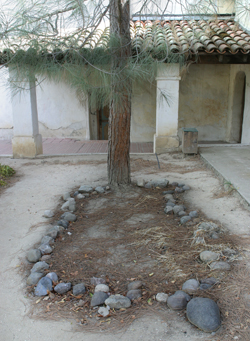 |
The Read family murders - San Miguel, 1848
The first really horrifying crime in the county's recorded history was the Read family murders, where all nine family members were killed, including an infant.
At the time, the California Missions had been secularized, most considered abandoned and open to the public. The San Miguel Mission was being used as a tavern by the Read family, and in October of 1948 Mr. Read was entertaining a group of sailors, deserters from a ship-of-war docked in Monterey.
Read had had some luck mining for gold in the Sierra Nevadas, and he made the mistake of displaying his wealth to the sailors. According to an account by John M. Price of Pismo Beach (yes, Price Street is named after him), "The deserters, after seeing the display of gold and the unguarded manner of their host, conspired to murder the family and secure the booty. The broad wilderness they were in, the defenseless condition of the victims, the ghostly surroundings of ruin, abandonment, crumbling walls and decay inspired them with a spirit of diabolism and invited them to the deed of horror."
Price and F. Z. Branch (Yep, Branch Street) came upon the grisly scene the day after the murders and "were too shocked to know at once what to do." More horrible still was that "even an infant had been brained by dashing its head against one of the pillars of the corridor."
Price and Branch sounded the alarm and led a posse in pursuit of the murderers, and over several days began to close the gap between themselves and the sailors. Finally, by the coast in Carpenteria, "the murderers were overtaken and a desperate battle ensued."
One of the posse was killed and others wounded, but all of the murderers were slain. "One of them rushed into the ocean in his panic of fear. He was fired upon as he swam, and sank to rise no more. The bodies of the others were left where they fell, as food for the vultures and coyotes," wrote Price.
The Read family is buried on the San Miguel Mission grounds in a small, unmarked grave. The building was reclaimed by the Catholic Church, which had held services there until the recent earthquake, which has made it uninhabitable, though the public can still tour the grounds.
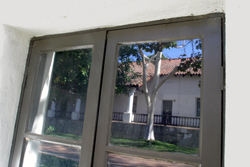 |
LAST VIEW? |
Lynchings - SLO Mission, 1850s
There was only one legal execution in the county in 1859, which probably took place on the SLO Mission grounds since the mission at the time housed the jail, sheriff's office, and courthouse. Luis Cariziza was hanged for the murder of Francisco Alviso, and the scaffolding for the execution was most likely erected near the corner of Broad and Monterey streets, near the public restrooms.
Prior to this legal execution, however, there were plenty of lynchings carried out by the Vigilance Committee, many of which occurred in that very spot on the mission grounds. In 1858, Walter Murray wrote a series of letters to the San Francisco Bulletin, in which he described 10 years' worth of "work" by the Vigilance Committee.
In one case, a posse in 1853 took after a group of outlaws who had murdered a peddler. They were tracked to Los Angeles, and three were hanged on the spot, a fourth returned to San Luis Obispo and hanged in town. Murray's letters chronicle one misdeed after another as well as how the various outlaws were dispatched.
Another account detailed how Nieves Robles was hanged at the mission, though his neck did not snap on the fall and he took more than 20 minutes to die.
Today, homeless people, locals, and tourists frequently gather on this spot to enjoy Mission Plaza, completely unaware of the number of men who met their demise at the end of a rope.
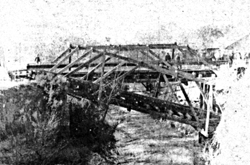 |
HANG 'EM LOW |
The Hemmi/Walker tragedy - Arroyo Grande, 1886
Three people died and one was badly wounded in 1886 in Arroyo Grande, two the victims of a land dispute, the other two killed at the hands of vigilantes.
A man named Peter Hemmi apparently wanted some land belonging to Eugene Walker. The two men owned abutting property, and Walker bought the land in question when the previous owner "was obliged to sell out" after she was harassed and harangued by Hemmi.
"Hemmi manifested the same ill-will toward the new owner, and annoyed him in many ways," according to a newspaper account of the time. Some accounts say Hemmi tore down fences, poisoned Walker's chickens, and turned his cattle loose.
The day of the murders, Hemmi and his 18-year-old son Julius arrived at the Walker household in the afternoon, and according to Mrs. Nancy Walker's account, while she and her husband worked in their garden she heard "the report of a gun" and saw her husband fall.
"My God, are you shot?" she asked, then saw Julius Hemmi with a rifle in hand, which he turned and fired on her.
Mrs. Walker said she "saw the blood spurt right out of my breast." Mr. Walker tried to get up but was again shot, as was the family dog. Mrs. Walker feigned death: "I remained perfectly still with my hand over my face until Julius Hemmi went away. I then crawled over to where my husband lay. I found him dead."
Mrs. Walker managed to make it to a neighbor's house two miles away, where she later made a statement to the authorities.
The Hemmis were taken into custody and, according to a newspaper account, were placed "in the calaboose at Arroyo Grande for safe keeping," but around midnight the same day, a group of men surrounded the jail, broke it open, took the prisoners to a railroad bridge, and hanged them.
"When the sheriff arrived in Arroyo Grande and inquired about the whereabouts of the prisoners, he was informed that he would find them under the bridge, and on repairing to that place found the bodies of murderers still suspended," continued the newspaper story.
Before he arrived, however, several local schoolchildren discovered the grisly sight, and upon telling their classmates, several more children left school in curiosity. The bodies were finally cut down about noon.
The railroad bridge was torn down and replaced several times and no longer exists, and the Walker house, too, is long gone, but the land (located on the road to Lopez Lake) over which three people died, remains - now in the possession of the Grieb family.
The love triangle double murder-suicide - Paso Robles/SLO, 1936
Shocking even by today's standards, the double murder of Jesse Sledge (shot dead in front of his 10-year-old daughter) and Fredus E. Gerst (who suffered for days with a gut shot before dying) by Work Progress Administration workman Ralph Hagerman rocked SLO County for days before the next big shock: Hagerman's suicide when he dove out the third floor window of the SLO County Courthouse after being questioned by the district attorney.
According to Earl Pickering, also present during the shooting (he was shot through the hand but escaped serious injury), the four men were gathered around Gerst's kitchen table drinking wine when Sledge and Hagerman, who had arrived together, began arguing about Sledge's estranged wife, Mary Anne. Hagerman took a gun that Sledge was carrying, a gun that Hagerman apparently owned but that had been taken by Sledge, and said, "Let's finish it now," and proceeded to shoot Gerst and Pickering before finally turning the gun on Sledge.
The next shot misfired, but Hagerman shot again, murdering Sledge in front of his daughter Betty June, who later told authorities that Hagerman said, "Well, we might as well settle this," before commencing firing, then said, There's yours," after shooting Pickering.
Hagerman went home after the shooting, where he was taken into custody without incident. He continued to deny he had anything to do with the murders, despite witness accounts to the contrary. After being interrogated - sticking to his claim of innocence - he dove out the window of the former Monterey Street courthouse, where he landed in a broken heap just feet from the district attorney who had been questioning him 10 minutes before, who happened to be walking on the sidewalk outside.
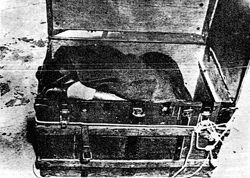 |
GRISLY DISCOVERY |
The Helen King trunk murder - SLO, 1947
One of the most sensationalized crimes ever committed in SLO County, this 1947 "trunk murder" as it was called, was front page news for nearly two weeks and was also chronicled in the February 1952 edition of true crime magazine Uncensored Detective, which devoted seven pages to the grisly slaying and subsequent capture of the killer. One sensationalized account in the local paper even claimed the body had been dismembered.
In July of 1947, Morley King strangled his wife Helen, stuffing her body in a trunk, where she was discovered behind the Andrews Hotel (now the site of the SLO County Library) by hotel cook Esther Ybarra, who noted "a peculiar odor," and upon summoning the police discovered King's body in a "badly decomposed state."
Deputy Coroner Fred M. Waters determined that Mrs. King had been dead more than a week. It was also noted in a newspaper account of the time that "considerable lingerie liberally trimmed with lace indicating that it was expensive" was found with the body.
The day after the body was discovered, it was reported that Mrs. King was a native of Turkey, and that prior to marrying Morley King, she'd been married to Count de Zoheb of Portugal, making her a countess.
It took authorities several years to eventually track down Morley King, who made the FBI's Most Wanted List during the ensuing hunt. Upon being returned to San Luis Obispo and justice, he told reporters, "In a sense, I'm glad it's over with."
He agreed to a plea bargain of five years to life for second-degree murder, and when asked if he felt remorse said, "I don't dig any holes for myself. What's done is done. And I figure if I pay my price, I can come out clean."
One account says King died in San Quentin, but state prison officials say the case is too old to have any records of what happened to him.
Every person who walks into the SLO County Library inadvertantly visits the site of Helen King's murder, where 57 years ago her maggot-covered body was discovered.
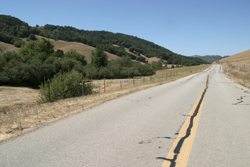 |
MASS MURDER! |
Mass murder, 43 dead - North County, 1987
The county's biggest mass murder was also its most efficient, since one shot essentially killed everyone involved.
On Dec. 7, 1987, disgruntled former US Air employee David Burke bought a one-way ticket on PSA Flight 1771 to San Francisco and used his old identification badge to circumvent security and smuggle a .44 caliber magnum handgun and six rounds on board.
He knew the supervisor who had fired him for drinking on the job and misappropriating funds was on board, and according to investigators, Burke shot the supervisor, a flight attendant, and then the pilot, sending the plane straight into a North County hillside off Old Creek Road about a mile south of Hwy. 46. Human tissue and twisted metal was spread across the hillside.
"There were just small parts of bodies. It's not a pretty sight," sheriff's sergeant Greg Slane was quoted as saying.
Today nothing distinguishes the crash site, which looks like any of the bucolic rolling hills along this spot of Old Creek Road equidistant between Cambria, Cayucos, and Templeton.
Glen Starkey hangs out in graveyards. He can be contacted at [email protected].